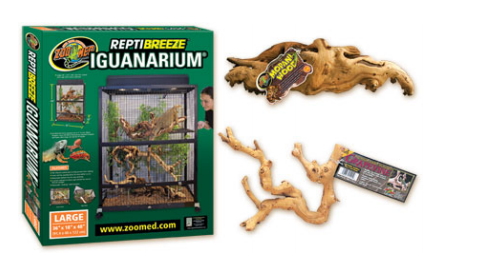Green Iguana
Home » Care Sheets » Green Iguana

The Green Iguana is the most popular “large sized” lizard kept in captivity. Although these lizards have been popular as pets, they are very demanding and are not for beginners. Their adult size and potential for aggressiveness make them a challenge to properly care for. The majority of iguanas available today are farm-raised in Central and South America.
• Common Name: Green or Red Iguana
• Scientific Name: Iguana iguana
• Distribution: Throughout Central and South America
• Size: 4-5′ • Life Span: 15-20+ years
• Green Iguanas grow up to 5’+ and will need to be housed in a large enclosure as adults.
• Hatchling and juveniles will need a minimum 30-40 gallon size terrarium.
• Zoo Med’s Iguanarium® is an excellent choice for medium to subadult Iguanas.
• All branches and cage décor must be secured to the enclosure because Iguanas are strong animals that will quickly rearrange their cage if allowed

• Daytime Terrarium Temperature: 80-85° F
• Basking Spot: 95-100° F
• Nighttime Temperature: 75-80°F
• Zoo Med’s Basking Spot Lamp, PowerSun®, Repti Halogen™ and Ceramic Heat Emitter are good choices for heating Iguana enclosures.

• UVB Lighting is essential for Iguanas to process calcium in captivity.
• Without UVB lighting Iguanas will develop serious health problems such as Metabolic Bone Disease (MBD).
• UVB Lighting should be left on for 10-12 hours per day and turned off at night.
• Zoo Med’s ReptiSun® linear and compact fluorescent lamps are a great choice for providing Iguanas with UVB. The PowerSun® is an excellent way to provide both UVB and heat all in one lamp!

• Cage carpeting such as Zoo Med’s Eco Carpet is the easiest substrate to maintain with Iguanas.
• ReptiBark®, Forest Floor™, and Eco Earth® can also be used.
• Iguanas are strong animals, and will quickly make a mess of substrates and other cage décor.

• Iguanas are herbivores that will prefer a varied green diet. Zoo Med’s pelleted Iguana Diet is formulated for the different growth stages of Iguanas and is a perfect maintenance food. All other food items can be mixed into a “mash” of moistened pellets.
• Juvenile Iguanas can be offered occasional insects such as crickets and mealworms, yet insects should make up less than 5% of total diet.
• Plant matter should represent greater than 50% of your Iguana’s diet. We recommend collard and mustard greens, romaine lettuce, escarole, zucchini, graded carrots, cooked sweet potatoes, and other quality vegetables.
• Stay away from cabbage and iceberg lettuce. Spinach should be offered only on rare occasions.
• Fruits can be offered as treats and should make up less than 10% of total diet. Good fruit choices include; bananas, melons, seedless apples, strawberries, tomatoes, grapes and peaches.
• ReptiCalcium® and ReptiVite™ with Vitamin D3 should be added to food as directed.

